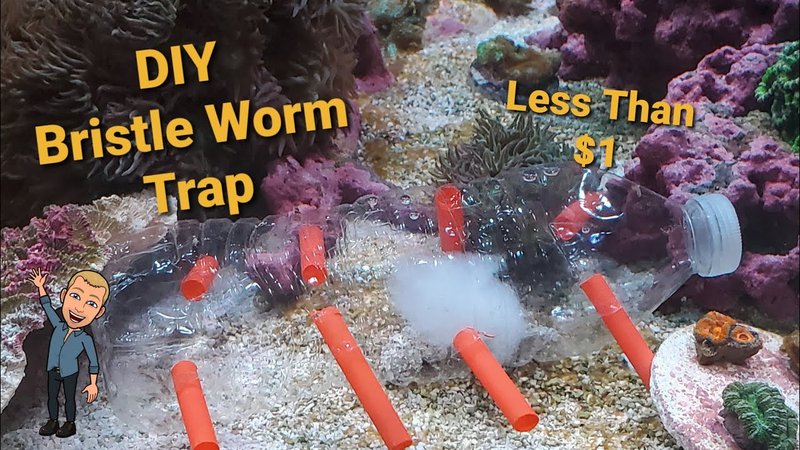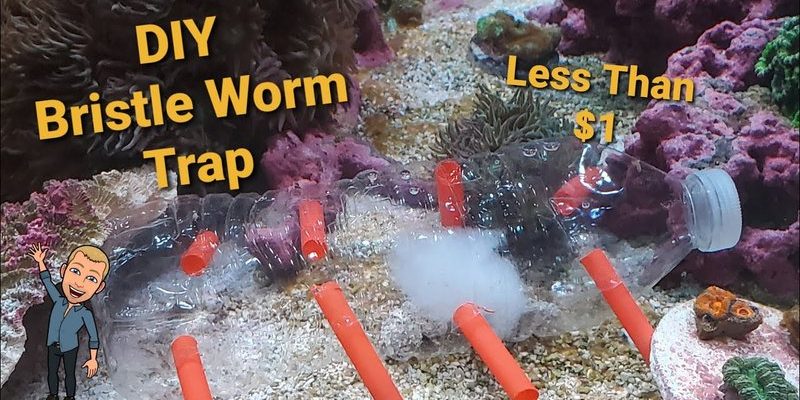
If you want to tackle the bristle worm issue without resorting to harsh chemicals or disrupting your aquatic ecosystem, DIY traps are your best bet. Think of these traps as the clever devices in a game show, designed to catch the culprits while keeping your tank safe and sound. Let’s dive in and explore some effective DIY traps to rid your aquarium of bristle worms—all while keeping things simple and safe.
Understanding Bristle Worms and Their Impact
Before we jump into how to remove them, let’s take a moment to understand what bristle worms are. These marine creatures typically have long, segmented bodies covered in bristles (hence their name) and can vary in color from reddish-brown to vibrant hues. They thrive in your aquarium’s substrate or among the rocks, and while they feed on decaying organic matter, they can also become a threat to live coral and other marine life when their population gets too high.
You might be wondering, “How do bristle worms even get into my tank?” Often, they hitch a ride on live rock or live sand. It’s like getting a surprise guest who brings along their entire entourage! If you’re seeing too many of these little fellas in your tank, that could indicate an imbalance in your ecosystem, often caused by overfeeding or excess organic waste.
Understanding how they function in your aquarium is crucial. In moderation, bristle worms can help clean up leftover food and other decaying materials. However, too many bristle worms can lead to unhealthy competition for food, potentially harming your other tank inhabitants. So, let’s explore ways to keep them at a manageable level.
DIY Trap
One of the simplest ways to catch bristle worms is by using a bottle trap. You might remember doing a similar thing with DIY fishing traps as a kid—it’s easy and effective! Here’s how to set up your bottle trap:
1. **Materials Needed**:
– A plastic bottle (like a soda bottle)
– Scissors
– Bait (such as shrimp or fish food)
– Weights (like rocks or gravel)
2. **Instructions**:
– Cut the bottle in half. Keep the top half with the spout intact for now.
– Place your bait inside the bottom half of the bottle.
– Invert the top half and insert it into the bottom half, creating a funnel. This allows the worms to enter but makes it hard for them to escape.
– Place weights around the trap to ensure it stays submerged in your tank.
Setting up this trap at night can increase your chances of catching the most worms, as they tend to be more active when the lights are off.
DIY Trap
Another effective method is the jar trap, which works on the same principle as the bottle trap but is even easier to set up. You’ll need just a few items around your home.
1. **Materials Needed**:
– A glass jar (like a mason jar)
– Bait (e.g., shrimp, fish scraps)
– Fishing line or string
2. **Instructions**:
– Place your bait at the bottom of the jar.
– Tie a piece of fishing line or string around the jar. This way, you can easily pull it out of the tank when it’s time to check for catches.
– Submerge the jar in your tank, keeping the opening just below the water surface.
Check the jar every few hours. You’ll be amazed at how many bristle worms are drawn to the bait!
DIY Trap
If you’re looking for a more durable option or have a larger tank, a PVC pipe trap might be the way to go. This trap can last longer and is perfect for catching multiple worms at once.
1. **Materials Needed**:
– A small piece of PVC pipe (about 1-2 inches in diameter)
– End caps for the pipe
– Bait (again, shrimp or fish food)
2. **Instructions**:
– Drill several small holes along the length of the PVC pipe to allow the worms to enter.
– Add bait inside the pipe.
– Cap one end of the pipe and leave the other end open.
– Secure the trap to the tank with a fishing line or clip it to the side of your aquarium.
The worms will enter through the holes to get to the bait but will find it challenging to escape. Just remember to check this trap daily and clean it out as necessary.
Maintenance and Monitoring
After you’ve set up your traps, it’s essential to monitor them regularly. Here’s what you should keep in mind:
– **Check Your Traps Daily**: Depending on the level of infestation, you might catch several bristle worms each day. The more you remove, the better for your tank’s health!
– **Replace Bait**: The bait can spoil or lose its effectiveness, so make sure to replace it every couple of days to keep attracting those worms.
– **Observe Your Tank**: Pay attention to any changes in your other marine life. If you notice your corals looking healthier or your fish being less stressed, you’re on the right track!
Keep an eye on the overall environment of your aquarium. Reducing the amount of organic waste and being mindful of overfeeding can help prevent a bristle worm resurgence.
When to Seek Professional Help
While DIY traps are effective, sometimes the situation can get overwhelming. If you’re noticing that your traps aren’t catching enough worms or if their population continues to rise despite your efforts, it might be time to consider professional help. Some aquarists find success with biological control, like introducing natural predators that keep bristle worm populations in check.
Consulting with a professional aquarium service can provide you with additional strategies tailored specifically for your setup. They can also help assess the overall health of your tank and offer advice on how to keep your aquatic environment balanced.
Dealing with bristle worms doesn’t have to be a headache. With a few simple DIY traps and a bit of patience, you can manage their population while keeping your aquarium flourishing. Remember to check your traps regularly, replace bait, and monitor your aquarium’s health.
By taking these steps, you not only keep your aquatic environment safe but also learn more about the delicate balance of your tank. Whether you opt for bottle traps, jar traps, or PVC traps, every small effort helps make a difference. Happy trapping!

